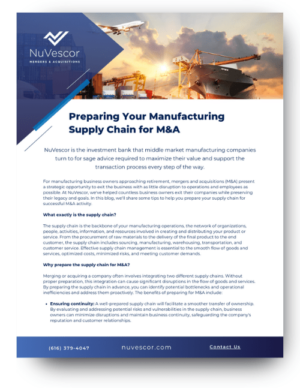Preparing Your Manufacturing
Supply Chain for M&A
For manufacturing business owners approaching retirement, mergers and acquisitions (M&A) present a strategic opportunity to exit the business with as little disruption to operations and employees as possible. At NuVescor, we’ve helped countless business owners exit their companies while preserving their legacy and goals. In this blog, we’ll share some tips to help you prepare your supply chain for successful M&A activity.
What exactly is the supply chain?
The supply chain is the backbone of your manufacturing operations, the network of organizations, people, activities, information, and resources involved in creating and distributing your product or service. From the procurement of raw materials to the delivery of the final product to the end customer, the supply chain includes sourcing, manufacturing, warehousing, transportation, and customer service. Effective supply chain management is essential to the smooth flow of goods and services, optimized costs, minimized risks, and meeting customer demands.
Why prepare the supply chain for M&A?
Merging or acquiring a company often involves integrating two different supply chains. Without proper preparation, this integration can cause significant disruptions in the flow of goods and services. By preparing the supply chain in advance, you can identify potential bottlenecks and operational inefficiencies and address them proactively.
The benefits of preparing for M&A include:
- Ensuring continuity – A well-prepared supply chain will facilitate a smoother transfer of ownership. By evaluating and addressing potential risks and vulnerabilities in the supply chain, business owners can minimize disruptions and maintain business continuity, safeguarding the company’s reputation and customer relationships.
- Maximizing value – Prospective buyers or investors often assess the efficiency and reliability of the supply chain as a critical factor in determining the company’s value. A well-organized supply chain with robust processes and optimized logistics can increase competitiveness, attract potential buyers, and potentially lead to a higher valuation during negotiations.
- Mitigating risk – By proactively preparing the supply chain for M&A, you can identify and address risks in advance. This can protect the company from unforeseen disruptions during the transition process.
- Streamlining operations – Preparing the supply chain for M&A presents an opportunity to optimize operations and streamline processes. Enhancing overall efficiency contributes to cost savings and profitability, positioning the business as an attractive investment for potential buyers.
Strategies for M&A Preparation
It is essential to allocate sufficient time and resources to thoroughly prepare the supply chain, as it plays such a critical role in the overall success of the sale of your business. As you move into M&A and begin to prepare, consider these tactics:
- Assess the current supply chain – Before embarking on an M&A journey, you need to have a comprehensive understanding of your existing supply chain. Identify your suppliers, production processes, inventory management practices, logistics, and distribution networks. This assessment will serve as the baseline against which you and your purchaser can compare and align the supply chains of merging entities.
- Build your triage team – Set up a core team to prepare the supply chain. Include stakeholders from various sections who can provide valuable input on supply chain issues and respond quickly to unexpected events.
- Develop or update your supplier database – An M&A supplier database should contain key supplier data such as annual spend, location, contacts, supply agreements, and agreement termination date. This will be useful during the sale, as it gives potential investors and purchasers real visibility into your supply chain.
- Manage your supplier and vendor relationships – Supplier relationships are critical to a manufacturing supply chain. Communicate openly with your suppliers about any impending M&A and its potential impact on their operations.
- Communicate with your employees – The success of M&A activities heavily depends on the people involved. Ensure open and transparent communication with your employees about the changes taking place. Engage them in the integration process and address any concerns they may have about job security, roles, and responsibilities as far as you can.
In the dynamic world of manufacturing, preparing your supply chain for mergers and acquisitions (M&A) is more than just a strategic move—it’s a pathway to ensuring a seamless transition that safeguards your legacy and goals. The supply chain isn’t just a series of steps; it’s the lifeline of your operations. By proactively addressing potential bottlenecks, streamlining operations, and nurturing relationships with suppliers and employees, you’re not just facilitating a change in ownership, you’re also nurturing your business’s future success.
At NuVescor, we specialize in helping manufacturing business owners in Western Michigan and the Midwest and beyond build the value of their companies as they prepare to exit. Contact us to learn more about how we can help you make the best decision for you, your company, and your shareholders.

